British Pacific Phosphate Carrier
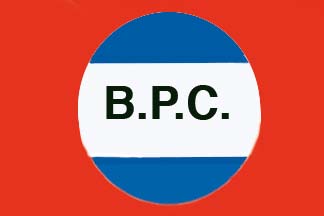
 Vessels owned or chartered by the British Phosphate Commission (BPC) voyaged in the Pacific well off normal trade lanes to the remote islands of Nauru and Ocean Island to load phosphates for Australia and New Zealand. These twin circular shaped islands were topped with a thick crust of phosphate and lay just south of the equator in the Gilbert Islands Group.
Vessels owned or chartered by the British Phosphate Commission (BPC) voyaged in the Pacific well off normal trade lanes to the remote islands of Nauru and Ocean Island to load phosphates for Australia and New Zealand. These twin circular shaped islands were topped with a thick crust of phosphate and lay just south of the equator in the Gilbert Islands Group.
Nauru has a coastline of 18.6 miles with no harbour, and thus vessels were loaded by barges inside the reefs, and later at cantilever loading cranes, the first of these was commissioned in 1930. Mining commenced at Ocean Island in the year 1900 by the Pacific Islands Company Ltd. with principals of John T. Arundel (1841-1919) and Lord Stanmore (1829-1912), the financiers that negotiated with the German company that controlled the licences to mine on the two islands.
The Gilbert Islands are scattered over a vast area of the Pacific of five million square kilometres, and consist of four groups of atolls, circular or horse shoe shaped masses of coral enclosing a lagoon. The groups are the sixteen Gilbert Islands including Tarawa atoll, the eight Phoenix Islands, the three Line Islands, and Nauru and Ocean Island. Spanish explorers had first sighted the islands in the sixteenth century, but the first Europeans to land were British in 1764. The Polynesians were converted to Christianity by British missionaries, and the Gilbert Islands joined with the Ellice Islands in 1902 to form a British protectorate, to which Ocean Island had been added in 1900.
A start in the shipping of phosphate was made in 1901, with a few thousand tonnes shipped in 1901 and some 13,350 tonnes shipped in the following year. These totals would have been higher if the fully loaded chartered vessel Moonstone had not been lost on Ocean Island’s reef in July 1901. In 1902, the interests of the Pacific Islands Company Ltd. were merged with Jaluit Gesellschaft of Hamburg to form the Pacific Phosphate Co. Ltd. (PPC) to mine both Nauru and Ocean Island. Germany had annexed Nauru in 1888, and under a policy established by the German administration, royalty payments were made to the landowners. Nauru had been taken by Australian forces during World War I, and thus the British Phosphate Commission (BPC) could be formed on 1st July 1920 by a Board of Australian, New Zealand and British representatives to purchase the assets of the PPC for £3.5 million, and began to manage the assets from 1st January 1921. In 1921, the royalty payments to Nauruans were fixed at 1.5% per tonne of phosphate extracted. This increased to 7% in 1927 and in the 1930s to 9% of the phosphate revenues. Significant profits were made by the BPC during their sixty year extraction tenure, running into millions of U.S. dollars per year.
Chartered vessels were used by the BPC at first, including vessels of the Union Steamship Company of New Zealand and Tasmanian Steamers (Pty) Ltd., as well as larger tramps e.g. Luciston 5,017/24, and the unlucky Ooma 3,991/05 lost at Ocean Island on 8th February 1926, and Hartfield 4,661/15 dragging her moorings inshore and damaging herself at Nauru in the same month. Ocean Transport 4,643/13 of Houlder Brothers was lost at Ocean Island on 30th January 1928 after her propeller had fouled the lines of the mooring buoy. Nauru Chief 2,934/21, completed by the Nyland Verft yard at Oslo, was purchased while fitting out for Norwegian owners, and was the first owned vessel for the BPC, with the fleet managed for many years by A. H. Glaze, the General Manager of the BPC in Melbourne. Cantilever number 1 was completed at Nauru in September 1930 with a loading rate of one thousand tonnes per hour, followed by Cantilever number 2 in 1961, after having been designed and built in Australia with a greater loading capacity of 1,500 tonnes per hour.
The first vessel to have a ‘Tri’ prefix to her name (to signify the tripartite agreement of Australia, New Zealand and Britain) was the new steamer Triona 4,413/31 completed by the Govan yard of Harland & Wolff Ltd. She was followed by the motorships Triaster (1) 6,032/35, and the sisters Triadic and Trienza, both 6,378/38, all fitted with bow sheaves to handle the mooring lines. The permanent moorings off Nauru were anchored in 160 fathoms of water, and ships loading at the island had to tie up at these mooring buoys. Periodically, the cables anchoring the buoys were taken up for inspection or replacement, and this work was done by one of the four pre-war ships, all fitted with mooring laying gear to run over the cable sheaves at the bow. Several Bank Line ships were chartered for the phosphate trades in pre-war and post-war years.
Triaster (1) made her first visit with phosphates to Port Adelaide on 26th September 1937, two years after her completion by Lithgows. She had five holds, three forward and two aft of the machinery spaces. The shelter deck could be used for cargo or as basic accommodation for islanders making the voyage. She was equipped with four five tonne derricks on the foremast and on the mainmast, with the winches housed at the base of the masts. The BPC fleet had black funnels pre-war, with British officers, Chinese cooks and stewards, and Filipino deck crew. Triaster (1) was propelled by a Kincaid-B&W airless injection four cycle single acting diesel of 3,600 bhp at 115 rpm to give a service speed of 10.5 knots.
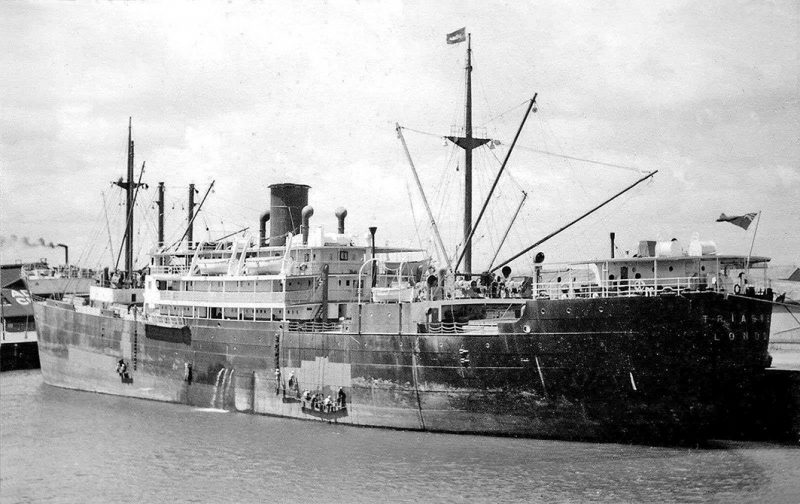
The little BPC fleet was decimated by the German surface raiders Komet and Orion at Nauru on 8th December 1940, losing Triona, Triadic and Triaster (1) and two chartered vessels in Komata 3,900/38 of USSNZ and Vinni 5,181/37 owned by Ditlev-Simonsen of Norway. The Japanese then invaded Nauru in 1942 with 7,000 troops stationed on the island building military installations and three runways at the airbase, with two thirds of the Nauruans deported to Truk atoll. Nauru was liberated at the end of the war on 13th September 1945, but it was a mass of tangled and destroyed military equipment, and the surviving islanders did not return until 1st January 1946.
The island mining equipment had to be replaced and operations did not get into full swing again until 1949. Post-war BPC fleet replacements included the standard type naval supply ship Dungeness of 10,000 dwt built at Vancouver in 1945 and purchased by Pacific Shipowners Ltd. on 10th July 1947 and renamed Levuka and rebuilt into a passenger cargo-liner by the Burrard yard at Vancouver. She made only one voyage to Sydney (NSW) for Pacific Shipowners Ltd. as she was sold to BPC a few weeks later and renamed Triadic (2), and departed on her first voyage from Melbourne to Nauru on 17th May 1948. She joined the standard war built 10,000 dwt Triona (2) completed by Lithgows in February 1943. The twin screw Islander 1,598/29 was Yard number 416 from the Grangemouth Dockyard, and carried two dozen first class passengers and 52 crew members to Christmas Island, to the south of Java in the Indian Ocean, for the Christmas Island Phosphate Commission. She was managed by BPC from 1949 when she was sold to the Commonwealth of Australia, management continuing until 1960.
The subject of this article, Triaster (2), joined the BPC fleet on 21st October 1955, and her slightly larger near sister Tri-Ellis in 1958, both from the Govan yard of Harland & Wolff Ltd., to give a fleet of five BPC vessels in 1958. Tri-Ellis was one foot wider and deeper than her near sister Triaster and could thus lift 13,950 tonnes of phosphates. Tri-Ellis was named after Sir Albert Ellis (1869-1951), who was a prospector in the Pacific and the ‘father’ of the Pacific phosphate industry, having first discovered phosphate deposits on Nauru and Ocean Island in 1900, and he became the BPC Commissioner for New Zealand between 1921 and 1951. Tri-Elis was given a domed top to her funnel, and could be identified from Triaster by her reworked bridge and accommodation block for only a dozen passengers.
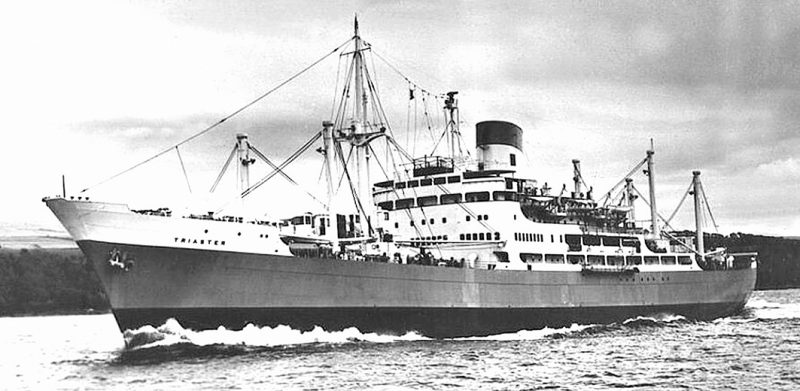
Triaster (2)
This fine passenger cargo-liner carried 48 passengers and 12,000 tonnes of phosphates to Australian and New Zealand ports from completion on 21st October 1955, having been launched at the Govan yard of Harland & Wolff Ltd. exactly six months earlier by Mrs. David Calder. She was an open shelterdecker with six holds, and six square hatches with sides measuring 28 feet, and two decks in her hull, Main Deck and Lower Deck. Above these was the Shelter Deck, Fo’c’stle and Bridge Deck, Promenade Deck, Boat Deck and Navigating Bridge Deck with the wheelhouse top above. The dimensions of Triaster (2) were length overall of 531 feet with an overhang of her heavily raked bow being 46 feet, moulded beam of 67.6 feet, and depth to Shelter Deck of 42.0 feet, and loaded draft of 28.0 feet. She had provision in her fo’c’stle for her own moorings in order to hold the ship steady at the cantilever loading berths. The electrically operated deck machinery by Clarke, Chapman & Co. Ltd. of Gateshead consisted of two capstans on the fo’c’stle and two on the aft shelter deck, a windlass on the fo’c’stle, and inside the fo’c’stle was a special mooring winch-windlass, capable of handling deep moorings up to a range of 270 fathoms of chain cable, which was released over a bow roller.
She had a part electrically welded hull and was given longitudinal framing at the sides and bottoms of the holds as well as transverse framing. The Shelter and Main Decks were continuous fore and aft, with the Lower Deck forming the steering gear compartment. A tunnel deck was arranged in way of numbers 4, 5 and 6 holds, and subdivision of the hull was by means of seven watertight and two oiltight bulkheads. There were fresh water and ballast water tanks beneath and at the sides of the tunnel deck. The double bottom tanks were for the carriage of fuel oil or water ballast. Another feature of Triaster (2) was her design of pillarless holds, which had ramped boundaries to facilitate easy mechanical handling of the phosphate cargoes. These unobstructed holds were specially designed and unusual in a cargo-liner of her size.
She was rigged with a foremast with a fixed topmast and three pairs of derrick posts, all of which were unstayed. There were ten 5 tonne, two 10 tonne, and one heavy lift 25 tonne derrick, operated by a dozen converter type electric winches with remote control, cargo battens were not fitted. Steering was by means of electro-hydraulic steering gear of the four ram type, and manufactured by Brown Brothers & Co. Ltd. of Edinburgh. This gear was controlled by a telemotor installation in the wheelhouse, with in addition mechanical control from the aft docking bridge. The navigating bridge had the latest radar, gyrocompass, direction finders and electric signalling devices.
Public Rooms
The accommodation of the staterooms for 48 passengers, and the Lounge, Dining Room, Entrance Hall and the elegant Verandah Cafe was of a very high standard equal to that found in larger passenger liners. The passenger staterooms were on Bridge Deck and Boat Deck in two single berth, seventeen two berth, and four three berth staterooms. All staterooms were outside rooms, with the two berth rooms being spacious and beautifully decorated in light oak panelling and equipped with a long dressing table and a mahogany set of drawers between the beds, with a large side folding mirror above, together with two easy chairs and foot stools.
The Lounge was located forward on Bridge Deck to port, with the Dining Room occupying the central and starboard side of this forward looking area. The Lounge had large windows all along the port side and the curved fore end. The window curtains had a light green and yellow floral design on a soft silver grey background. An alcove was arranged in the starboard wall, and there were curved recesses at each end, into which were built writing desks. Abaft the alcove were glazed entrance doors, and a large and very well equipped glass fronted bookcase against the after bulkhead. The panelling was in well figured white sycamore, to contrast with the Nigerian walnut skirtings. All of the easy chairs and tables were of sycamore, with the coffee tables faced with plastic veneers. The card tables had reversible tops, with plastic veneers on one side, and green baize on the other. The card table chairs, as well as those of the writing tables, were upholstered in soft tan coloured hide. The remaining comfortable easy chairs with matching settees and a plethora of tub chairs were upholstered with a cotton tapestry with a woven stripe in shades of primrose and green. Loose covers were provided in heavy green and yellow linens, as well as in green flowered cretonne. The floor covering had a tile effect in warm beige and was bordered in green and grey, with a beautiful coloured carpet in the centre.
The Dining Room to starboard of the Lounge had walls panelled in figured Canadian maple. The long, curved forward end and the starboard side consisted almost entirely of windows, which were curtained with a contemporary cotton print in colours to match the upholstery. The furniture of a sideboard, carver dining armchairs, as well as the dumb waiters recessed into the panelling, was of red beech. The chairs were upholstered in smoke blue and lime green hide, and the table tops were covered by sandy yellow coloured Lionide material. The sideboard was positioned in the centre of the after bulkhead, above which was a large mirror. The entrance doors were flanked by glazed side panels, and the twin ‘in’ and ‘out’ service doors were faced in plastic veneers. The floor covering was very similar to that of the Lounge, except that border was a rust colour.
The Dining Room and Lounge were linked by an Entrance Hall, which was panelled in figured aspen. A curved settee was covered in beautiful blue hide and occupied the starboard forward corner. The Chief Steward’s office was abaft the Lounge, and a decorative grille, finished in satin chrome, embellished the opening to his office. Walnut furniture was arranged in the Entrance Hall, and the easy chairs and armchairs were upholstered in hide in blue and ivory tones. The unusual but contemporary floor design was in cream with rust and grey borders. A beautiful feature of the Entrance Hall was an illuminated relief map of the entire South Pacific, on which a magnetic model of the ship could be moved to show the midday position of the vessel.
The elegant Verandah Cafe was located on the Boat Deck in a large space separated from the open deck by a long, glazed, folding screen. At the fore end of the Verandah was a long bar counter, which was faced with eau-de-nil and pale green veneers, and topped with a material in imitation wood grain. The Verandah walls were also panelled in pale green veneers, while around the bar, the decorative treatment of the room was in English beechwood. The contemporary floor design was of patterned green and yellow, while the settees and easy chairs were covered with grey and yellow Lionide material. Scarlet bar stools added a final touch of colour to the room.

The design of the public rooms was carried out by Heaton, Tabbs & Co. Ltd. of London, and the spacious suite for the Master, as well as the cabins of the Chief Officer, Chief Engineer and Second Engineer were panelled in selected wood veneers. A large Smoking Room for the Navigating Officers was provided on Boat Deck and was tastefully decorated and furnished. All crew members had single berth cabins, the walls of which were panelled in Warerite plastic veneers. The furnishings of each cabin included settees with drawers under, wardrobes, and washbasins with hot and cold running water. A large crew recreation room was strikingly decorated, with upholstery and floor coverings of colourful material.
All of the public rooms and passenger staterooms were air conditioned throughout, and the associated refrigeration plant was supplied by the well known firm of J. & E. Hall Ltd. of Dartford. Separate laundries and drying rooms were provided for each section of the ship. In the passenger spaces, as well as for the officers and stewards, there were several Hoover washing machines, while the Australian crew laundry had a larger Bradford washing machine. Overall, the standard of the fitting out of all of public rooms, staterooms and crew accommodation in the four decks in the ‘midships superstructure was extremely good.
Main Propelling And Auxiliary Machinery
The main diesel engine was a Harland & Wolff-B&W single acting two stroke cycle, opposed piston, cross-head version of six cylinders burning heavy grade fuel oil. A service speed of fourteen knots was achieved at 110 rpm in continuous service from the 6,500 bhp diesel engine, with the four bladed manganese bronze propeller having been fitted solidly with the boss. Air for starting the engine was stored in two air reservoirs, each of capacity 540 cubic feet. However, scavenging air was supplied by two positive rotary blowers mounted on the back of the engine, and driven by roller chains from the engine crankshaft. Fresh water cooled the cylinders from telescopic pipes in the forced lubrication system. The lower part of each cylinder liner was enveloped in the scavenge belt, and was effectively cooled by the steady flow of the air on its way to the inlet ports.
There were two boilers for providing hot water to the staterooms, one at the base of the funnel that used exhaust gases and fuel oil, and the other in the engine room that used fuel oil only. There were four 300 kilowatt diesel driven generators arranged in parallel and of six cylinder four stroke cycle, each provided with a lubricating oil pump, and lubricating oil cooler and filter. Compressed air from the auxiliary starting air bottle was used to start the generators, and there was also a stand-by connection from the two main engine air reservoirs.
Pumps and additional auxiliary machinery equipment in the engine room included four lubricating oil filters and oil pumps, each with a capacity of 325 tonnes of oil per hour. Two fuel pumps, two ballast pumps each rated at 500 tonnes per hour, one Duplex fuel oil filter, two fresh water circulating pumps, two fuel valve water circulating pumps, one salt water circulating pump, four sea water circulating pumps, one emergency fire and bilge pump, two fuel oil transfer pumps, one bilge and deck washing pump, two domestic water pumps, one general service pump, and one stand-by fuel oil pump.
Triaster (2) In Service
Triaster served for fifteen years for the BPC from 1955 to 1970 loading phosphates at Nauru and Ocean Island in the Pacific, and at Christmas Island in the Indian Ocean. She loaded general cargo northbound at Melbourne together with refrigerated food supplies in six refrigerated lockers between numbers four and five ‘tween decks. Special filter ventilation systems were built into the ship to keep the white phosphate dust out of the passenger and machinery spaces, and she had water ballast wing tanks in the forward ‘tween decks to keep the rolling down to a minimum when fully loaded with phosphates.
Nauru is shaped like a hat with the coastal fringe forming the brim and the raised interior the crown of the hat. The interior makes up 80% of the island, from where the white phosphate was mined and taken to the cantilevers to be loaded into Triaster (2) and her near sister Tri-Ellis of 1958, as well as chartered ships such as the Hogarth tramp Baron Minto 7,801/59 that loaded here in the 1960s. In 1968, Nauru took over the management of its people when Independence was granted by the trusteeship committee of the United Nations. The Nauru Government took over the running of the phosphate mines in 1970 after paying US$13.5 million to the BPC. The high grade phosphate continued to be mined until 1993 and shipped to be used to fertilise pasture land in Australia, New Zealand and Japan, with millions of tonnes of white phosphate rock carried by Triaster (2) and Tri-Ellis to each of the three Pacific Rim countries.
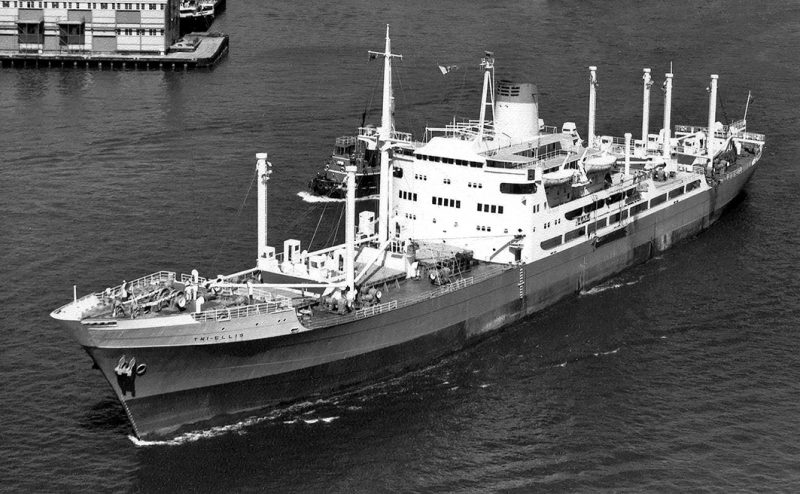
Nauru Pacific Line (Npl)
Triaster (2) was sold in 1970 to the Nauru Government and renamed Rosie D and given a blue funnel with a thin yellow line near the top to represent the equator, as well as a large white 12-pointed star to represent the dozen tribes of Nauru. She ran for the Nauru Pacific Line (NPL), formed in 1969 by the Nauru Government whose council was composed of tribe leaders. Rosie D was named in honour of Rosie Detudamo, the wife of Timothy Detudamo, an early Nauru chief. She was given a light grey hull and white masts, posts and derricks, and continued loading phosphates for another five years southbound, with general and refrigerated cargo northbound, with calls also at Port Moresby in Papua New Guinea, Suva in Fiji and Apia in Samoa on occasion. An eighteen minute film had been shot on board Triaster (2) entitled ‘A Visit to Ocean Island and Nauru’, which began with her sailing from Melbourne and also showed unloading ports such as Newcastle (NSW).
Triaster (2) as Rosie D took her third name of Taiyuan in 1975 when sold to the Chinese Government, masquerading as the Tai Yuan Shipping Inc. of Mogadishu in Somalia. She changed flags to Panama in 1976, and then arrived at Kaohsiung on 3rd February 1978 to be broken up by the Chien Nan Iron and Steel Co. Ltd. The BPC had used chartered bulk carriers in the 1970s to transport the phosphates e.g. the twin funnelled Cape Hawke of 23,710 dwt and completed in 1971 and which took the last cargo from Ocean Island on 25th November 1979, and the bulker Scotspark of Denholms of 26,505 dwt and built in 1971, and Valetta of Ditlev – Simonsen of 27,484 dwt and built in 1968. These bulkers were replaced in the Nauru Pacific Line fleet by their owned bulkers Kolle D of 32,466 dwt (named after Kolle de Roburt, wife of the Head Chief and President of the Nauru Republic) and Rosie D (2) of 26,855 dwt.
Tri-Ellis, near sister of Triaster (2), also joined the Nauru Pacific Line in 1974 and was renamed Tryphena until sold in 1978 and renamed Man Tat under the Panamanian flag and arrived for scrapping at Kaohsiung on 2nd September 1980. The first ship of the Nauru Pacific Line had been Eigamoiya 4,426/69 completed by the Robb-Caledon yards with three holds forward of the accommodation, and a much smaller hold aft. She served until the NPL was bankrupted in 1993,calling at her regular ports of call of Melbourne, Port Moresby, Lae, Rabaul, Nauru, Newcastle (NSW), Geelong and Melbourne with her refits done in Japan.

Nauru is traditionally a matriarchal society, and Eigamoiya was named after Queen Eigamoiya, an early leader in the mid 19th century. Eigamoiya was not a great sea-keeping ship in the long rollers of the Pacific, as she had a good amount of flare at her bow and tended to slam into the seas instead of riding above them. She had a set of derricks on her foremast and two electric cranes to work the three forward holds.
Nauruans had become rich on the royalties and profits of the phosphate mining, although the manual labour was imported from other Pacific Islands and from the Philippines and China. The profits were dissipated in all types of projects including an airline Air Nauru set up in 1980, and the Nauru Pacific Line was starved of operating money, with Eigamoiya regularly arrested in Melbourne for non-payment of bills, until these were paid two weeks later, and she was released to continue to take fresh water and supplies to Nauru and return with phosphates. Another passenger cargo-liner in the NPL fleet was Enna G, named after Enna Gadabu, wife of an early Nauru chief, and the former good looking Prinses Margriet 9,341/61 of Oranje Line of Holland on services to the U.S.A. and Canada. Enna G was impounded in Wellington by the New Zealand Seamen’s Union over Pacific islander crewing issues for a period of eight weeks. It was resolved by a stormy meeting of President Hammer de Roubet of Nauru and Prime Minister Kirk of New Zealand.
Enna G was converted into a cruise ship with container carrying capacity on her forward decks for Pacific cruising to San Francisco via Majuro (Marshall Islands), Ponape (Micronesia), Truk (Caroline Islands), the Mariana Islands and Hawaii. However, she fell foul of American cabotage laws and was prevented from carrying passengers, and thus had to return to the Melbourne to Nauru service, but she now carried no passengers as all Nauruans went by their own airline to Melbourne. She was laid up at Melbourne for one year due to engine breakdowns and financial problems, before being finally laid up at Majuro for her last seven years between 1983 and 1990. She then sailed to Thap Sakae in Thailand where she arrived for breaking up on 8th September 1990.
The Nauru Pacific Line (NPL) also used the former Booker Line cargo-liner Booker Challenge 8,537/72 and 10,700 dwt renamed as Eigugu, the former Federal Palm 3,179/61 used in the Caribbean by the West Indies Shipping Corporation and managed out of Port of Spain by Furness, Withy & Co. Ltd. She had three holds and three hatches served by five derricks and two cranes, and was renamed as Cenpac Rounder for Central Pacific services. She was replaced by the former Japanese engines aft cargo ship Kyokyu Maru 5,668/70 and 9,100 dwt and renamed Cenpac 2. She had three holds and three hatches, with deep tanks for carrying vegetable oil, and had a heavy lift derrick of eighty tonnes capacity for lifting 125 TEU of containers, as well as four of twenty tonnes capacity and one of 15 tonnes capacity.
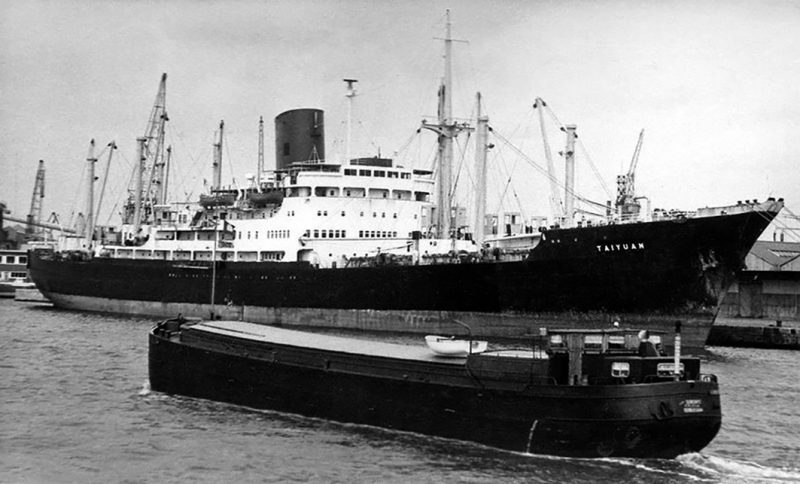
However, the rich deposits of Nauru phosphates had been exhausted by 1993, and so had the extravagant lifestyle of the Nauruans, with the NPL declared bankrupt in 1993 and their high rise office building in Melbourne of Nauru House sold off. Nauru is supported today by financial aid measures from the Australian Government, and is a partner in the Pacific Forum Line.
Postscript
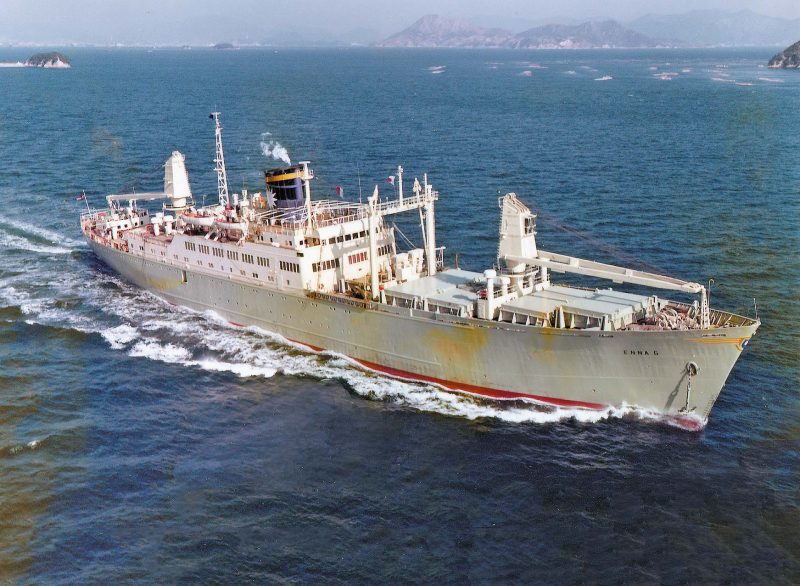
Triaster and her near sister Tri-Ellis belonged to the many classes of good looking British cargo-liners built in British yards in the 1950s for Ellerman Line, Blue Star Line, Port Line, Clan Line and many other shipping lines. Despite the poor level of investment in British shipyards, the very high standard of naval architecture was evident in these excellent and streamlined designs. The yellow funnels with blue tops of three post-war cargo-liners built for the British Phosphate Commission in British yards during post-war years were seen regularly in Australian and New Zealand ports. This trio and the many other handsome British cargo-liners voyaging to the Antipodes gave a very favourable impression of the Red Duster Merchant Navy until this was all changed by the appearance in the late 1960s of boxy container ships.

Nauru has celebrated the ships of the British Phosphate Commission and the Nauru Pacific Line on many of its stamps. The four stamp set of 1924 shows Nauru Chief off the island, the Eigamoiya is depicted on the blue 7 cent stamp of 1974 commemorating the 175th Anniversary of the First Contact with the Outside World, Enna G (ex Prinses Margriet) is depicted on the blue/grey 10 cent stamp of the South Pacific Forum, and the green Nauru 3 cent stamp of 1968 shows a vessel being loaded at the cantilevers, with the 15 cent and 25 cent stamps of 1975 celebrating the formation of the BPC in 1920.
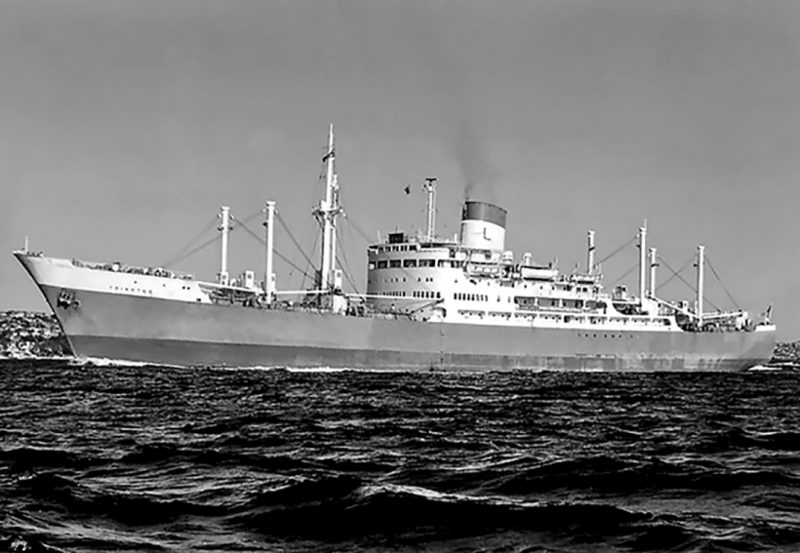
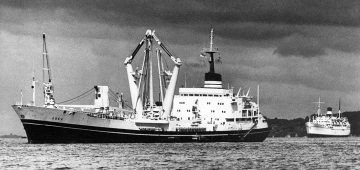



Comments
Sorry, comments are closed for this item